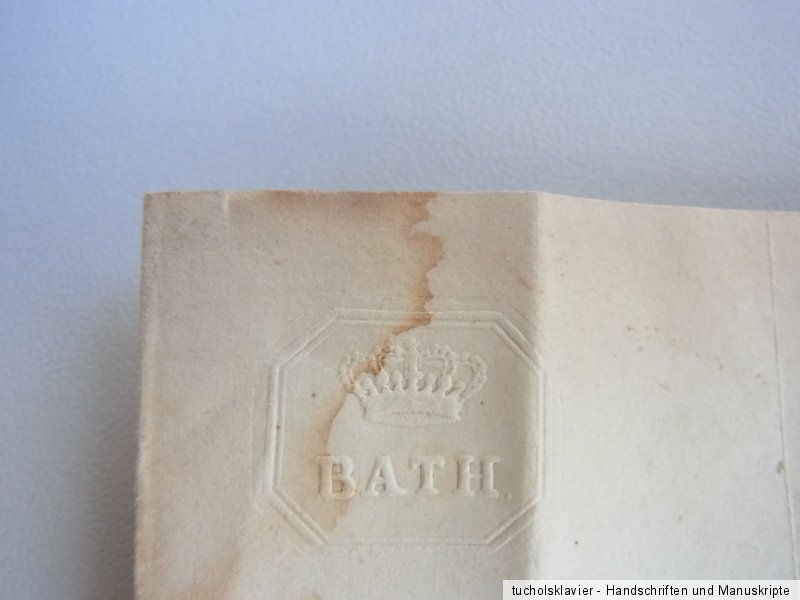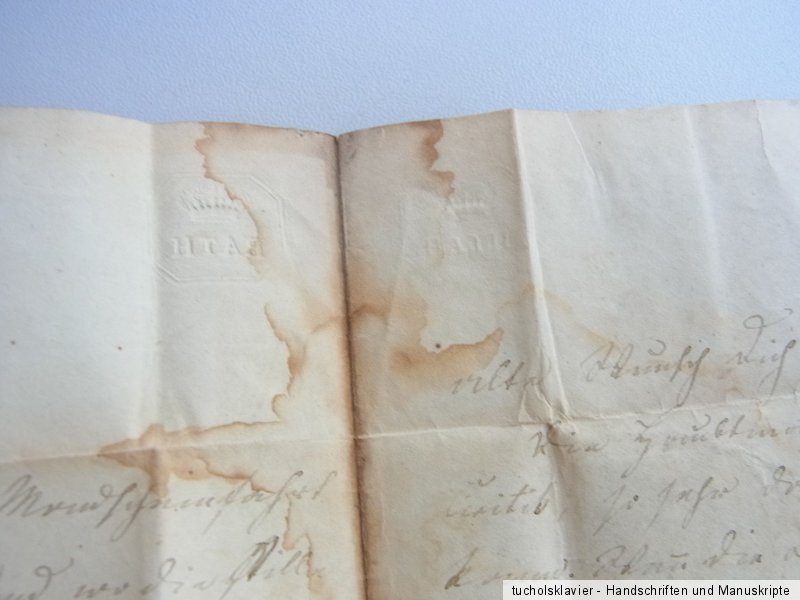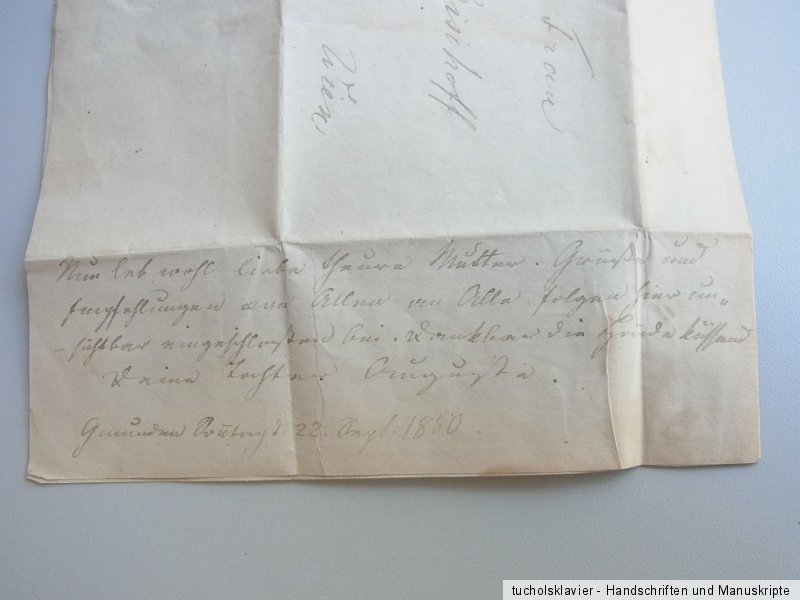Writer Auguste von LITTROW (1819-1890): Letter 1850
Description
– See more pictures below! –
You are bidding on one handwritten, signed letter the German-Austrian writer (Ps. Otto August) and women's rights activist Auguste von Littrow (1819-1890), Daughter of the doctor Ignaz Rudolf Bischoff Edlen von Altenstern (1784-1850).
Dated Gmunden, 22nd September 1850. -- Auguste von Littrow was on vacation there with her husband Karl and their children Otto and Gabriele.
Addressed to her mother Johanna von Bischoff, b. Cow (born *4. August 1798 in Breslau, † 28. August 1891 in Weinhaus), the unter published several books with valuable memories under the name Johanna von Bischoff. Her husband had died about two months earlier.
Addressed to "Mrs. Mrs. Hofräthin v. Bischoff in Vienna, City 625."
Excerpts: "Dear dear mother // I just received Yours ? I wanted to say ? Dear letter, but since it contained nothing but fatal things to you, I can only subjectively attribute this adjective to it. This is the first Sunday that you will not receive a letter from us, and your kind indulgence with which you ask me in today's letter not to put too much effort into writing is a very lovely encounter, as I was already silently thinking about mine yesterday and today I was annoyed by the omission. The reason for this is the divine weather, which caused us to go on a three-day trip to the Almsee and Kremsmünster, from which we only returned home yesterday evening. The Almsee is the most secluded Velsenthal you can imagine, to which you reach through the loveliest, greenest valleys called Grünau. We stayed there overnight in the Seehause, an old hunting lodge, and enjoyed the magic of a wonderful moonlight trip that Remy took on the lake and where the silence of the night made the echo repeating 14 syllables appear in a truly fairy-like manner. The next completely fog-free morning delighted us no less and Gabriele and Otho (!) were in constant ecstasy. Since Karl's time was already getting very short and our route had taken us halfway to Kremsmünster, we took advantage of the beautiful evening and drove there, where we were welcomed and accompanied in the old, loving way by the two clergy friends. [...]
It makes me all the more sensitive to know that you are going through Allen sorts of fatalities and that every time you have joy you have to think that you experience nothing but discomfort. In such moments, the old desire to see you here awakens with twice as much power.
I find the Haubtmannsberg story to be under criticism, so much so that I can't be bothered by it. If people don't present a bill for the suppers, I really don't know what they're asking for. [...]
In order to take revenge for the Heynau jokes, I report the following verses circulating here.
[...]
I live quietly and get my money
Speaks Minister Thierfeld
Pray diligently and learn nothing
Says the Minister of Education.
The Minister, Mr. von Bruck
Thinks we have enough money
And the minister Baron Krauss
Don't mind the credit.
Baron Kulmer is also a minister
He sleeps at night and eats during the day.
[...]
Now farewell, dear dear mother. Greetings and recommendations from Allen to all follow invisibly enclosed here. Kissing your hands with gratitude, your daughter Auguste."
Posted (with postmarks).
Scope: 3 text pages and an address page (21.2 x 14.3 cm).
Condition: Paper browned and stained (unsightly waterstained); Paper slightly wrinkled, with small creases. The left part of the exit stamp is missing (a stamp there has obviously been removed). bplease note also the pictures at the end of the item description!
At the same time, I am offering other autographs by Auguste von Littrow!
Internal note: Littrow in 20-05-20
Pictures













TRIXUM: Mobile-optimized auction templates and image hosting
About Auguste von Littrow, her father, her husband and her son Otto (source: wikipedia):
Auguste Wilhelmine von Littrow (*13. February 1819 in Prague; † 23. March 1890 in Vienna) was a German-Austrian writer (Ps. Otto August) and women's rights activist of the 19th century. century.
Life and work: Auguste Wilhelmine, married von Littrow, a daughter of the doctor Prof. Ignaz Rudolf Bischoff (since 1836) Edler von Altenstern (1784–1850), married the astronomer Karl Ludwig von Littrow (1811–1877), a son of the astronomer Joseph Johann von Littrow (1781–1840), shortly after her twentieth birthday in 1839 and lived with her husband in Vienna.
After just a short time, the predominantly literary Littrowsche Salon developed into a sought-after meeting place and center of intellectual Vienna, which at times included Hermann Bonitz, Josef Danhauser, Marie von Ebner-Eschenbach, August Eisenmenger, Ernst von Feuchtersleben, Ottilie von Goethe and Franz Grillparzer , Friedrich Hebbel, Rudolf von Jhering, Joseph Lewinsky and Franz Miklosich. Franz Grillparzer, who was a friend of hers, jokingly called her “Frau Astronomus”, probably because of her penetration into the previously unknown existence of poorer, working women, known as Weiber, in Vienna.
Auguste Wilhelmine von Littrow was the author of memoirs and articles on women's employment and the recruitment of certified teachers at elementary schools after the introduction of compulsory education for boys and girls in Austria-Hungary. At 13th. In November 1866, together with Iduna Laube and Helene von Hornbostel, the wife of the industrialist Theodor von Hornbostel, she founded the Association for Economic Progress, later the Vienna Women's Employment Association, which was founded by the women's rights activist Lucia Laube (1872–1945), daughter by the geologist Gustav Carl Laube (1839–1923), president of the Prague German Women's Acquisition Association and member of the Federation of Austrian Women's Associations.
Ignaz Rudolf Bischoff, Edler von Altenstern since 1836 (*15. August 1784 in Kremsmünster; † 15. July 1850 in Meidling) was an Austrian doctor.
Life: Ignaz Bischoff, who came from Upper Austria, studied medicine at the University of Vienna and became a doctor of medicine in 1808. During the French occupation in Vienna he headed a department of a French hospital.
In the years 1813–1825 Ignaz Bischoff lived in Prague, where he was a professor at Charles University in Prague, director of the Second Medical Clinic and chief physician at the General Hospital in Prague. During this time he made great contributions to the dissemination of vaccination against the smallpox epidemic, which claimed numerous lives among the population, and was considered a resource during the typhus epidemics in Bohemia. He was then professor of physiology at the Josephs Academy in Vienna from 1826.
In the years 1826–1832, at the Medical-Surgical Military Academy, the Collegium-Medico-Chirurgicum-Josephinum, Ignaz Bischoff was professor of special pathology, holder of the chair for physiology until 1849, and from 1841 and definitely from 1847 onwards the army's top field doctor of the Austrian Empire and head of the Josephinum. During this time, this institution gained a recognized reputation in medical circles in Europe. Bischoff was also chairman of the permanent field medical commission, the military medication directorate in the revolutionary year of 1848, general staff doctor and member of the Vienna Medical Forum and a founding member of the Society of Doctors in Vienna.
Elevation to the nobility and family: In 1836 Ignaz Bischoff was raised to the hereditary Austrian nobility with the title Edler von Altenstern.
He was born with Johanna. Kuh (1798–1891), who published several books with valuable memories under the name Johanna von Bischoff. She was also active as a benefactor who later founded the women's home in Meidling. This was created from the villa of the Bischoff family, who had lived there as a summer residence since 1836. The rest of the year the family lived in an apartment on Stephansplatz in Vienna. The salon of the Bischoff Villa in Meidling was a meeting place for well-known personalities, including the painter Friedrich von Amerling, the writer Heinrich Laube, the astronomer Joseph Johann von Littrow and his son Karl Ludwig von Littrow, with whom the Bischoff von Altenstern has had a daughter, Auguste von Littrow was married in 1839. His daughters Auguste and Luise were taught drawing in their parents' home by Josef Danhauser.
Ignaz Rudolf Bischoff Edler von Altenstern died in his home in Meidling in 1850 and was buried in the Meidling cemetery.
Fonts
Observations on typhus, 1815
Views of homeopathic disease theory, 1819
Principles of practical medicine, 3 volumes, 1823–25
Basic principles of human nature, 4 volumes, 1837–39
Textbook of Physiology, 1838
Treatises on pulmonary consumption, 1843
On Poisonings, 1844
Honors
In 1874, Bischoffgasse in Vienna-Meidling was named after him.
Karl Ludwig Littrow, Edler von Littrow since 1836, also given in the literature as "Carl Ludwig Littrow" (* 18. July 1811 in Kazan; † 16. November 1877 in Venice) was an Austrian astronomer, specialist author and director of the Vienna University Observatory.
Life and work: He was the son of the astronomer Joseph Johann von Littrow, who was knighted in 1836, and his brother Heinrich was a cartographer. Karl Ludwig assisted his father as an assistant from 1831 and followed him as director of the University Observatory in Vienna in 1842, after he had made himself known in particular through an adaptation of Hell's observation of the transit of Venus from 1769.
In 1847, Karl Ludwig von Littrow and Otto Wilhelm von Struve were appointed commissioners for assessing the trigonometric connection between Russia and Austria-Hungary. As university dean in 1850, he contributed greatly to the permanent introduction of the German university institutions that were then attempted in Austria, and since 1862 he took a lively part in the work of Central European degree measurement. He also provided a new method of determining longitude at sea, worked with Edmund Weiss on the meteorological observations of the Vienna Observatory and translated “Outline of a History of Astronomy in the Beginning of the 19th Century”. Century” by George Biddell Airy. In 1858 he was elected a member of the Leopoldina.
Littrow wrote, among other things, a “Popular Geometry”. In 1844 he published his “Directory of Geographical Location Determinations” in Johann Samuel Traugott Gehler's Physical Dictionary, which he was able to publish separately in Leipzig in the same year (addendums 1846). Under his leadership, the “Annals of the Vienna Observatory” became one of the most important astronomical yearbooks.
Littrow pushed through the construction of the new University Observatory in Vienna, which his father had suggested. However, he did not live to see its completion.
In 1879 in Vienna-Währing (18. District) the Littrowgasse - along the observatory park - is named after him.
In 1839 Littrow married Auguste Bischoff, a German-Austrian writer and women's rights activist. His son Otto von Littrow, who died early, was the inventor of the Littrow spectrometer.
Fonts
The Toposcop on the St. Stephen's Tower in Vienna: an instrument that enables the tower keepers to always announce the location of a fire with the same certainty, day and night. Gerold, Vienna 1837 digital copy
Popular Geometry, 1839
Contribution to a monograph on Halley's Comet, 1834
Contribution to Adalbert Stifter The solar eclipse on August 8th July 1842
Geographical directory Location regulations, 1844
Physical Meetings of the Planets, 1859
JJ v. Littrow's Comparison of the Most Excellent Measures, Weights and Coins, Beck, 1844.
Karl von Littrow Commemorative Medal: The Karl von Littrow Commemorative Medal was an Austrian bronze award that was issued in honor of the astronomer from 1878. It was an anticipated award for the new Vienna University Observatory, which was only completed in 1883. This was a project of the honoree that was started during his lifetime on his initiative, but was not yet finished.
The medal, created by the engraver Anton Scharff, weighs around 107 grams and has a diameter of 64 millimeters and shows a half-left bust of the namesake on the front with an inscription "*CAROLO DE LITTROW HUMANITATE INGENIO DOCTRIN INSIGNI" and on the back the new ( (planned and under construction at the time of issue) university observatory as a front view and the two-line text “HARUM AEDIUM AUCTORI” and the year “MDCCCLXXVIII” in Roman numerals.
Otto von Littrow (*14. February 1843 in Vienna; † 7. November 1864 ibid) was an Austrian physicist and astronomer.
He was the son of the astronomer Karl Ludwig von Littrow (1811–1877), who, like his father Joseph Johann von Littrow, was director of the Vienna Observatory. Littrow studied with Hermann von Helmholtz and Gustav Robert Kirchhoff at the University of Heidelberg. Although he died of typhus at the age of 21 shortly after completing his doctorate, he made a name for himself with spectral devices (Littrow spectrometers) and heliostats.